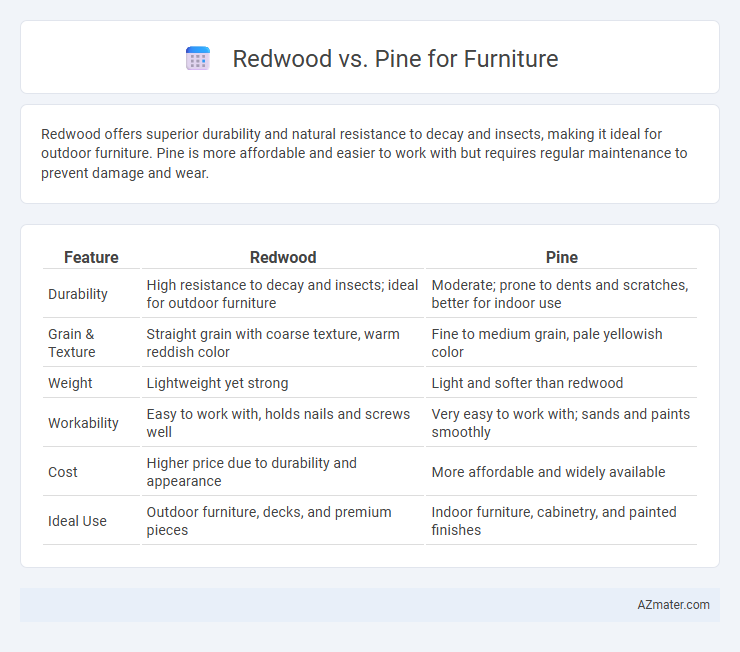Redwood offers superior durability and natural resistance to decay and insects, making it ideal for outdoor furniture. Pine is more affordable and easier to work with but requires regular maintenance to prevent damage and wear.
Table of Comparison
| Feature | Redwood | Pine |
|---|---|---|
| Durability | High resistance to decay and insects; ideal for outdoor furniture | Moderate; prone to dents and scratches, better for indoor use |
| Grain & Texture | Straight grain with coarse texture, warm reddish color | Fine to medium grain, pale yellowish color |
| Weight | Lightweight yet strong | Light and softer than redwood |
| Workability | Easy to work with, holds nails and screws well | Very easy to work with; sands and paints smoothly |
| Cost | Higher price due to durability and appearance | More affordable and widely available |
| Ideal Use | Outdoor furniture, decks, and premium pieces | Indoor furniture, cabinetry, and painted finishes |
Introduction: Redwood vs Pine for Furniture
Redwood and pine offer distinct advantages in furniture making, each valued for its unique characteristics. Redwood is prized for its natural resistance to decay, rich reddish hue, and durability, making it ideal for outdoor and high-end furniture. Pine, favored for its affordability, light color, and ease of shaping, is commonly used in budget-friendly and rustic indoor furniture designs.
Key Differences Between Redwood and Pine
Redwood features natural resistance to decay and insects, making it ideal for outdoor furniture, while pine is softer and more prone to dents and scratches, better suited for indoor use. Redwood typically has a richer, reddish hue with prominent grain patterns compared to the lighter, more uniform appearance of pine. Pricing for redwood tends to be higher due to its durability and aesthetic qualities, whereas pine is more affordable and widely available.
Wood Appearance: Color and Grain Comparison
Redwood furniture is characterized by its rich reddish-brown color and prominent, straight grain pattern that enhances its natural beauty and elegance. Pine features a lighter, pale yellow or creamy hue with a more knotty and rustic grain, often showcasing distinct swirls and imperfections. The contrasting color palettes and grain textures make redwood ideal for sophisticated, warm-toned pieces, while pine suits casual, country-style furniture designs.
Durability and Strength: Redwood vs Pine
Redwood offers superior durability and resistance to decay compared to pine, making it ideal for outdoor and heavy-use furniture due to its natural oils and dense grain. Pine, while generally softer and less durable, is more affordable and easier to work with, but it is prone to dents and scratches over time. The choice between redwood and pine hinges on the need for long-lasting strength versus cost-effectiveness and ease of customization in furniture projects.
Workability and Ease of Construction
Redwood offers superior workability due to its fine grain and consistent texture, making it easier to cut, shape, and sand without splintering, ideal for intricate furniture designs. Pine, while softer and more readily available, can be prone to dents and splinters during construction but allows for faster assembly due to its lightweight nature. Both woods accept stains and finishes well, though redwood's resistance to warping and shrinkage enhances long-term durability in furniture projects.
Resistance to Decay and Insects
Redwood offers superior resistance to decay and insect damage compared to pine, making it an ideal choice for outdoor and moisture-exposed furniture. Its natural oils and tannins provide long-lasting durability and protection without additional chemical treatments. Pine, while more affordable, requires thorough sealing and maintenance to prevent deterioration from pests and rot.
Environmental Impact and Sustainability
Redwood furniture offers significant environmental advantages due to its natural resistance to decay, reducing the need for chemical treatments and extending product lifespan. Pine grows faster than redwood, making it a more rapidly renewable resource, but it often requires more pesticide use and chemical preservatives to enhance durability. Choosing sustainably harvested redwood certified by organizations like FSC supports forest conservation, while pine sourced from responsibly managed plantations can minimize deforestation impact.
Cost and Availability
Redwood furniture typically costs more than pine due to its durability and natural resistance to decay, making it a premium choice for outdoor pieces. Pine is widely available and more affordable, often used for indoor furniture where cost-efficiency and ease of working are prioritized. Availability of pine is higher in most markets, while redwood may be limited to regions where it is naturally harvested, impacting price and accessibility.
Best Furniture Types for Redwood and Pine
Redwood is ideal for outdoor furniture such as garden benches, patio sets, and Adirondack chairs due to its natural resistance to decay and insect damage, offering durability and a rich reddish hue. Pine is best suited for indoor furniture like children's furniture, bookshelves, and rustic-style tables because it is lightweight, easy to work with, and provides a warm, natural appearance that can be easily painted or stained. Both woods excel in different settings: redwood thrives in moisture-prone environments, while pine offers versatility and affordability for indoor applications.
Conclusion: Choosing the Right Wood for Your Furniture
Redwood offers superior durability, natural resistance to decay, and a rich reddish hue, making it ideal for outdoor and high-end furniture that demands longevity and aesthetic appeal. Pine, being more affordable and easier to work with, suits budget-friendly, lightweight, and indoor furniture where fast production is prioritized. Selecting between redwood and pine depends on balancing cost, durability needs, and design preferences to ensure your furniture meets functional and stylistic goals.

Infographic: Redwood vs Pine for Furniture
 azmater.com
azmater.com